
in the two days’ shooting was one hundred and juxt$freight
brace. He had: much fewer shots on the jaecpnd than on the
first day, but he .shejfc «better ; on the Saturday h^bagged+ppe
hundred and eighty head from three hundred and- twenty*
seven shots, which-was considered good shooting in a nJWkdfr-
of this nature, when a -chance, -however ;^ s |p p t t e .m a y
appear, is not to-be thrown away. His^iinpl&< » 1 W* .Q$§k:
Esq. loaded t|i^gun& a great part of^fiejlay on$d%tpi^a§fj
and, as a finale_to the" day’s.■>sport, shot at and killed the,last
bird, which his nephew had previously - missed.- Lady ^ n n
Coke was in the field a great part of- the day ; hcr.jjd ^ ^ iip,
carried refreshments-^fer the sportsmen her pony gig.
Lord Kennedy chose fpr^he^s^^eA| f histexpl^sj^Mont^gi^n-
4n Scotland, a man o r . belonging t q M a x w e l l ,
consideredr^(|ualr. to any lands' in,,-Scotland ffoi^j^Siig, Partridges.
On. th&.firsf .day.of trial Lis^ rdship|Mgged||fifty
brace, and on tlic second eighty-two brace ; freing:, inwall jone
hundred and thirty-twubrace.of Partridges in two d ap sr
A t the commencement of the Partridge-shootinggspa^ap,.
which im soTTie countries-of Europe occurs earlier, Ilian -with
us, beginning in the canton of Qeneva, fr^r4^]toG,e^Ipnt. the
15th of August,—thoyqupg, birds, wh.|p»dislurbed .and jepa?
rated, will, after, resting in s ile n S for a'time, endeavour do
get back to the field-they were bred in, - apparently In-search
of their former companions. Later ;hr the 'season, the.whole
covey, when flushed, will take-tp: the woods in spun di-friu-,
and frequently when they have become strong on,,the-wing,
the remains of,’eeT^l;T,covies ^ i t e , .forming, unpack, and are
then very wild and difficult to approach.
Mr. Selby observes that the Partridge is _ found to vary
considerably in .size, according to situation, and the*different
nutritive qualities.of fpp,j|l thus,, thelargest are met with in
districts where an abundance of grain .prevails, whilst upon
the precincts of moors, ^here but an inconsiderable portion
of arable land is offered ho them, they are much inferior in
:^C ' ' although^pferhaps by no meaiis ' evincing a similar infe-
ribMtyin point of flavour; '
-tit has'been, observed to also, that on some heathy districts
in^uaieyh as the Hurtwbod and Bagshot Heath, the
’Partridges 'seldom freqnieiit the corn-lands, but subsist on
heath and hurtle-berriti; These birds are not so- white in
Ih^ffesK^wliën.'^^edf as others, and havi- some of the flavour
tqf? the Grmis^f'
^ ^ l lP a r t r id g e isM ^ en erally distributed over this country
as t’o 5make of particular localities ûnpdocssary'V
bVituthough plfen^fî^lin s'om^iPjthe low: grounds
of psyfi&d, /Mr. Mâe^llivt%’’,saÿsfl there are .none on the
islands*of the o u te ro r'“tfèstfem Hebrides-. M. Nilsson in-
;|^des ithfi bird in ‘lïi,s Fauna ôf Scandinavia, and it is founcL
in 1 suîtafÉ.'e 'dôcâiitïfipl* over Itfjb ' European continent1 to the
fibres' of tSft Mediterranean.' M. Temmindk* rskys it inhabits
Barbary and^iÈgypt *; and two Russian naturalists bave
included kHhitÉéir^a-tâlq^hë^&f tbe birds found- in the coUn*
-try betwefenSthe Black and the Caspian Seas, south of the
Caucasian' mountain range. Though stationary all the year
in ^central Europe, this bird^îs said to be migratory in the
countries that are at the limits of its geographical rangé.
. '.■’The adult male has fhe beak bluish whitë?;^ the irides
hazel; behind the 'éÿe, and above the ear-coverts* a small
triangulàr patch of naked red skin ; the forehead, the space
between the beak and thd ?eÿè,' with the feathers extending
backwards as far as the' ear-coverts, and downwards covering
1he front* of the neck and throat, bright yellowish chestnut;
top of thfe head and back of the neck greyish brown ; the
back and wing-coverts freckled with two shades of chestnut
brown on a ground of wood-brown, the shaft of each feather
forming a conspicuous’ streak of pale wood-brown ; the wing-
primaries, or flight-feathers, greyish brown, with transverse